Elena Mocanu
NeuroTrails: Training with Dynamic Sparse Heads as the Key to Effective Ensembling
May 23, 2025Abstract:Model ensembles have long been a cornerstone for improving generalization and robustness in deep learning. However, their effectiveness often comes at the cost of substantial computational overhead. To address this issue, state-of-the-art methods aim to replicate ensemble-class performance without requiring multiple independently trained networks. Unfortunately, these algorithms often still demand considerable compute at inference. In response to these limitations, we introduce $\textbf{NeuroTrails}$, a sparse multi-head architecture with dynamically evolving topology. This unexplored model-agnostic training paradigm improves ensemble performance while reducing the required resources. We analyze the underlying reason for its effectiveness and observe that the various neural trails induced by dynamic sparsity attain a $\textit{Goldilocks zone}$ of prediction diversity. NeuroTrails displays efficacy with convolutional and transformer-based architectures on computer vision and language tasks. Experiments on ResNet-50/ImageNet, LLaMA-350M/C4, among many others, demonstrate increased accuracy and stronger robustness in zero-shot generalization, while requiring significantly fewer parameters.
Dynamic Sparse Training versus Dense Training: The Unexpected Winner in Image Corruption Robustness
Oct 03, 2024



Abstract:It is generally perceived that Dynamic Sparse Training opens the door to a new era of scalability and efficiency for artificial neural networks at, perhaps, some costs in accuracy performance for the classification task. At the same time, Dense Training is widely accepted as being the "de facto" approach to train artificial neural networks if one would like to maximize their robustness against image corruption. In this paper, we question this general practice. Consequently, we claim that, contrary to what is commonly thought, the Dynamic Sparse Training methods can consistently outperform Dense Training in terms of robustness accuracy, particularly if the efficiency aspect is not considered as a main objective (i.e., sparsity levels between 10% and up to 50%), without adding (or even reducing) resource cost. We validate our claim on two types of data, images and videos, using several traditional and modern deep learning architectures for computer vision and three widely studied Dynamic Sparse Training algorithms. Our findings reveal a new yet-unknown benefit of Dynamic Sparse Training and open new possibilities in improving deep learning robustness beyond the current state of the art.
E2ENet: Dynamic Sparse Feature Fusion for Accurate and Efficient 3D Medical Image Segmentation
Dec 07, 2023

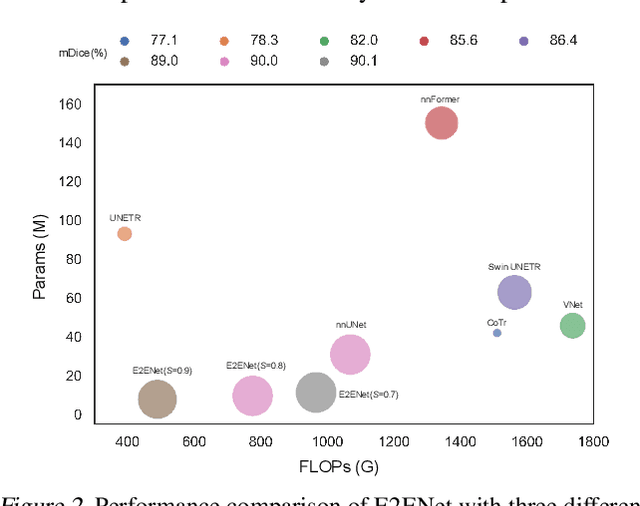

Abstract:Deep neural networks have evolved as the leading approach in 3D medical image segmentation due to their outstanding performance. However, the ever-increasing model size and computation cost of deep neural networks have become the primary barrier to deploying them on real-world resource-limited hardware. In pursuit of improving performance and efficiency, we propose a 3D medical image segmentation model, named Efficient to Efficient Network (E2ENet), incorporating two parametrically and computationally efficient designs. i. Dynamic sparse feature fusion (DSFF) mechanism: it adaptively learns to fuse informative multi-scale features while reducing redundancy. ii. Restricted depth-shift in 3D convolution: it leverages the 3D spatial information while keeping the model and computational complexity as 2D-based methods. We conduct extensive experiments on BTCV, AMOS-CT and Brain Tumor Segmentation Challenge, demonstrating that E2ENet consistently achieves a superior trade-off between accuracy and efficiency than prior arts across various resource constraints. E2ENet achieves comparable accuracy on the large-scale challenge AMOS-CT, while saving over 68\% parameter count and 29\% FLOPs in the inference phase, compared with the previous best-performing method. Our code has been made available at: https://github.com/boqian333/E2ENet-Medical.
Automatic Noise Filtering with Dynamic Sparse Training in Deep Reinforcement Learning
Feb 13, 2023Abstract:Tomorrow's robots will need to distinguish useful information from noise when performing different tasks. A household robot for instance may continuously receive a plethora of information about the home, but needs to focus on just a small subset to successfully execute its current chore. Filtering distracting inputs that contain irrelevant data has received little attention in the reinforcement learning literature. To start resolving this, we formulate a problem setting in reinforcement learning called the $\textit{extremely noisy environment}$ (ENE), where up to $99\%$ of the input features are pure noise. Agents need to detect which features provide task-relevant information about the state of the environment. Consequently, we propose a new method termed $\textit{Automatic Noise Filtering}$ (ANF), which uses the principles of dynamic sparse training in synergy with various deep reinforcement learning algorithms. The sparse input layer learns to focus its connectivity on task-relevant features, such that ANF-SAC and ANF-TD3 outperform standard SAC and TD3 by a large margin, while using up to $95\%$ fewer weights. Furthermore, we devise a transfer learning setting for ENEs, by permuting all features of the environment after 1M timesteps to simulate the fact that other information sources can become relevant as the world evolves. Again, ANF surpasses the baselines in final performance and sample complexity. Our code is available at https://github.com/bramgrooten/automatic-noise-filtering
Dynamic Sparse Network for Time Series Classification: Learning What to "see''
Dec 19, 2022

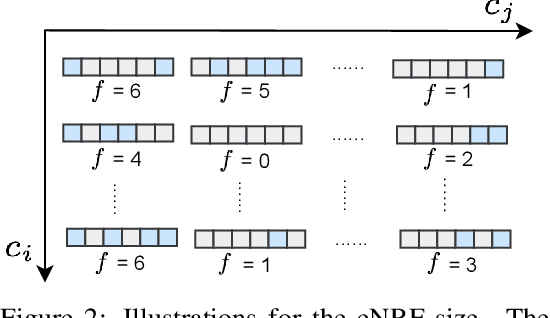

Abstract:The receptive field (RF), which determines the region of time series to be ``seen'' and used, is critical to improve the performance for time series classification (TSC). However, the variation of signal scales across and within time series data, makes it challenging to decide on proper RF sizes for TSC. In this paper, we propose a dynamic sparse network (DSN) with sparse connections for TSC, which can learn to cover various RF without cumbersome hyper-parameters tuning. The kernels in each sparse layer are sparse and can be explored under the constraint regions by dynamic sparse training, which makes it possible to reduce the resource cost. The experimental results show that the proposed DSN model can achieve state-of-art performance on both univariate and multivariate TSC datasets with less than 50\% computational cost compared with recent baseline methods, opening the path towards more accurate resource-aware methods for time series analyses. Our code is publicly available at: https://github.com/QiaoXiao7282/DSN.
FreeTickets: Accurate, Robust and Efficient Deep Ensemble by Training with Dynamic Sparsity
Jun 28, 2021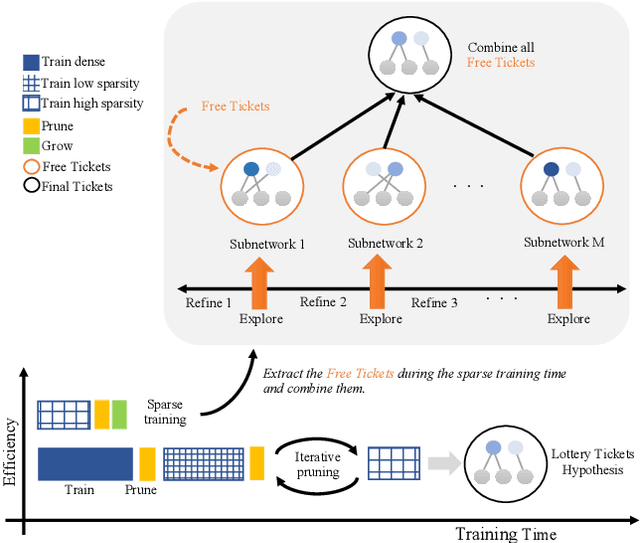



Abstract:Recent works on sparse neural networks have demonstrated that it is possible to train a sparse network in isolation to match the performance of the corresponding dense networks with a fraction of parameters. However, the identification of these performant sparse neural networks (winning tickets) either involves a costly iterative train-prune-retrain process (e.g., Lottery Ticket Hypothesis) or an over-extended sparse training time (e.g., Training with Dynamic Sparsity), both of which would raise financial and environmental concerns. In this work, we attempt to address this cost-reducing problem by introducing the FreeTickets concept, as the first solution which can boost the performance of sparse convolutional neural networks over their dense network equivalents by a large margin, while using for complete training only a fraction of the computational resources required by the latter. Concretely, we instantiate the FreeTickets concept, by proposing two novel efficient ensemble methods with dynamic sparsity, which yield in one shot many diverse and accurate tickets "for free" during the sparse training process. The combination of these free tickets into an ensemble demonstrates a significant improvement in accuracy, uncertainty estimation, robustness, and efficiency over the corresponding dense (ensemble) networks. Our results provide new insights into the strength of sparse neural networks and suggest that the benefits of sparsity go way beyond the usual training/inference expected efficiency. We will release all codes in https://github.com/Shiweiliuiiiiiii/FreeTickets.
Dynamic Sparse Training for Deep Reinforcement Learning
Jun 08, 2021



Abstract:Deep reinforcement learning has achieved significant success in many decision-making tasks in various fields. However, it requires a large training time of dense neural networks to obtain a good performance. This hinders its applicability on low-resource devices where memory and computation are strictly constrained. In a step towards enabling deep reinforcement learning agents to be applied to low-resource devices, in this work, we propose for the first time to dynamically train deep reinforcement learning agents with sparse neural networks from scratch. We adopt the evolution principles of dynamic sparse training in the reinforcement learning paradigm and introduce a training algorithm that optimizes the sparse topology and the weight values jointly to dynamically fit the incoming data. Our approach is easy to be integrated into existing deep reinforcement learning algorithms and has many favorable advantages. First, it allows for significant compression of the network size which reduces the memory and computation costs substantially. This would accelerate not only the agent inference but also its training process. Second, it speeds up the agent learning process and allows for reducing the number of required training steps. Third, it can achieve higher performance than training the dense counterpart network. We evaluate our approach on OpenAI gym continuous control tasks. The experimental results show the effectiveness of our approach in achieving higher performance than one of the state-of-art baselines with a 50\% reduction in the network size and floating-point operations (FLOPs). Moreover, our proposed approach can reach the same performance achieved by the dense network with a 40-50\% reduction in the number of training steps.
Sparse Training Theory for Scalable and Efficient Agents
Mar 02, 2021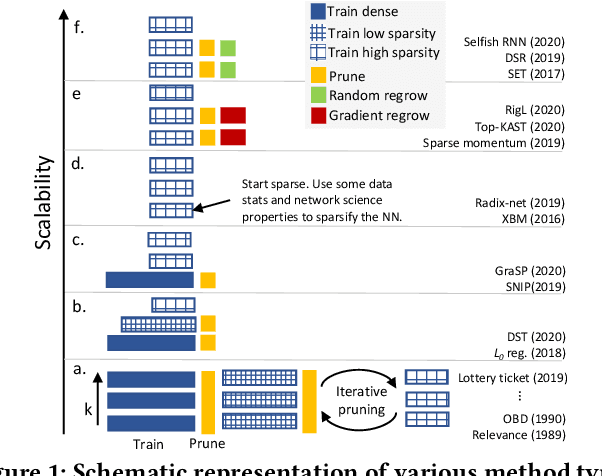
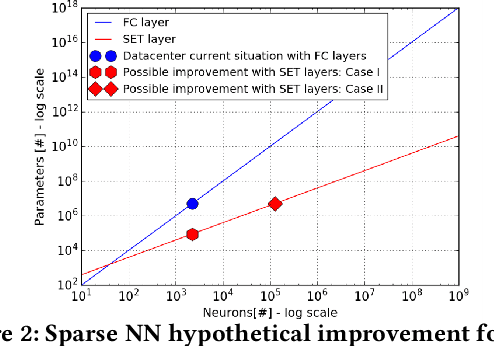
Abstract:A fundamental task for artificial intelligence is learning. Deep Neural Networks have proven to cope perfectly with all learning paradigms, i.e. supervised, unsupervised, and reinforcement learning. Nevertheless, traditional deep learning approaches make use of cloud computing facilities and do not scale well to autonomous agents with low computational resources. Even in the cloud, they suffer from computational and memory limitations, and they cannot be used to model adequately large physical worlds for agents which assume networks with billions of neurons. These issues are addressed in the last few years by the emerging topic of sparse training, which trains sparse networks from scratch. This paper discusses sparse training state-of-the-art, its challenges and limitations while introducing a couple of new theoretical research directions which has the potential of alleviating sparse training limitations to push deep learning scalability well beyond its current boundaries. Nevertheless, the theoretical advancements impact in complex multi-agents settings is discussed from a real-world perspective, using the smart grid case study.
Quick and Robust Feature Selection: the Strength of Energy-efficient Sparse Training for Autoencoders
Dec 01, 2020



Abstract:Major complications arise from the recent increase in the amount of high-dimensional data, including high computational costs and memory requirements. Feature selection, which identifies the most relevant and informative attributes of a dataset, has been introduced as a solution to this problem. Most of the existing feature selection methods are computationally inefficient; inefficient algorithms lead to high energy consumption, which is not desirable for devices with limited computational and energy resources. In this paper, a novel and flexible method for unsupervised feature selection is proposed. This method, named QuickSelection, introduces the strength of the neuron in sparse neural networks as a criterion to measure the feature importance. This criterion, blended with sparsely connected denoising autoencoders trained with the sparse evolutionary training procedure, derives the importance of all input features simultaneously. We implement QuickSelection in a purely sparse manner as opposed to the typical approach of using a binary mask over connections to simulate sparsity. It results in a considerable speed increase and memory reduction. When tested on several benchmark datasets, including five low-dimensional and three high-dimensional datasets, the proposed method is able to achieve the best trade-off of classification and clustering accuracy, running time, and maximum memory usage, among widely used approaches for feature selection. Besides, our proposed method requires the least amount of energy among the state-of-the-art autoencoder-based feature selection methods.
Scalable Training of Artificial Neural Networks with Adaptive Sparse Connectivity inspired by Network Science
Jun 20, 2018



Abstract:Through the success of deep learning in various domains, artificial neural networks are currently among the most used artificial intelligence methods. Taking inspiration from the network properties of biological neural networks (e.g. sparsity, scale-freeness), we argue that (contrary to general practice) artificial neural networks, too, should not have fully-connected layers. Here we propose sparse evolutionary training of artificial neural networks, an algorithm which evolves an initial sparse topology (Erd\H{o}s-R\'enyi random graph) of two consecutive layers of neurons into a scale-free topology, during learning. Our method replaces artificial neural networks fully-connected layers with sparse ones before training, reducing quadratically the number of parameters, with no decrease in accuracy. We demonstrate our claims on restricted Boltzmann machines, multi-layer perceptrons, and convolutional neural networks for unsupervised and supervised learning on 15 datasets. Our approach has the potential to enable artificial neural networks to scale up beyond what is currently possible.
* 18 pages
 Add to Chrome
Add to Chrome Add to Firefox
Add to Firefox Add to Edge
Add to Edge